Yesterday I went to Southall (again!). I had been invited to attend the Dastaar (turban) tying class, which takes place in the car park hall at Park Avenue Gurdwara every Sunday 3.30-4.30pm. It was great to see so many children. Most of them had brought Paghs (turbans) from home. They had all picked Pagh-styles, which they wanted. It was really funny. Someone wanted an AFRICAN pagh, another person wanted a DESI pagh, and another person wanted a "TOPI" (as in "HAT") style pagh. It was great fun and the children enjoyed it.
One kid tied a Desi pagh. Firstly, his face was weighed down by the pagh. Secondly, you couldn't see the poor kid's eyes! They were covered up! Thirdly, the pagh was bigger than the poor soul's face. Waheguru! (If you are interested in learning to tie a Dastaar there are some great videos on SikhNet.com)
Below are few examples of the many different pagh styles:
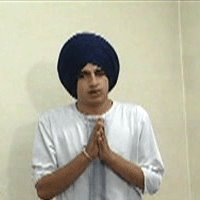
This is what I call "Jalandar" pagh, also known as "Nok" pagh. Very hardcore Desi style! I think its called Jalandhar pagh because it is huge and looks like he could have all of Jalandhar on his head. It reminds me of one the boys in the class yesterday, which I was referring to, who's dastaar was bigger than his head. Sat Naam!

A neat and tidy Dummalla Pagh. Nihang Singhs mainly wear this sytle of Dastaar. Its designed so that one keep ones in the tucked in the Dastaar.
Here's another Dumalla photo. This is Nihang Major Singh from Amritsar. Why on earth would someone want to tie such a huge pagh! 1) Neck pain, 2) How do you turn your head around, and 3) Bending down might be a problem (especially doing Matha Tekh!). Suppose whatever takes your fancy. Apnaa Aapnaa Sir Hai:
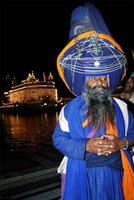

Ermm... Perhaps this can be identified as a "TOPI" (hat) pagh. (Doesn't tickle my fancy! I'll stick to my pagh sytle! waheguru.) By the way this is Achanak. Don't know if anyone remembers him?

More of Desi "College-Style" pagh. College Style because a lot of Panjabi boys in colleges and university in Panjabi tie a pagh like that. The bloke in the photo looks bit scary in the purple! Waheguru!
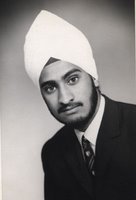
This is the "African" Pagh. Most Sikhs from Africa (who migrated there from Panjab) wear this style Pagh. Its get a sharp point at the end. A lot of people starch their pagh and so it ends up looking like "Blue Peter Pagh," i.e. here's one I made earlier.
Here's some photos of Sikh ladies' turbans (which slightly differs in style to males):
One kid tied a Desi pagh. Firstly, his face was weighed down by the pagh. Secondly, you couldn't see the poor kid's eyes! They were covered up! Thirdly, the pagh was bigger than the poor soul's face. Waheguru! (If you are interested in learning to tie a Dastaar there are some great videos on SikhNet.com)
Below are few examples of the many different pagh styles:

This is what I call "Jalandar" pagh, also known as "Nok" pagh. Very hardcore Desi style! I think its called Jalandhar pagh because it is huge and looks like he could have all of Jalandhar on his head. It reminds me of one the boys in the class yesterday, which I was referring to, who's dastaar was bigger than his head. Sat Naam!

A neat and tidy Dummalla Pagh. Nihang Singhs mainly wear this sytle of Dastaar. Its designed so that one keep ones in the tucked in the Dastaar.
Here's another Dumalla photo. This is Nihang Major Singh from Amritsar. Why on earth would someone want to tie such a huge pagh! 1) Neck pain, 2) How do you turn your head around, and 3) Bending down might be a problem (especially doing Matha Tekh!). Suppose whatever takes your fancy. Apnaa Aapnaa Sir Hai:


Ermm... Perhaps this can be identified as a "TOPI" (hat) pagh. (Doesn't tickle my fancy! I'll stick to my pagh sytle! waheguru.) By the way this is Achanak. Don't know if anyone remembers him?

More of Desi "College-Style" pagh. College Style because a lot of Panjabi boys in colleges and university in Panjabi tie a pagh like that. The bloke in the photo looks bit scary in the purple! Waheguru!

This is the "African" Pagh. Most Sikhs from Africa (who migrated there from Panjab) wear this style Pagh. Its get a sharp point at the end. A lot of people starch their pagh and so it ends up looking like "Blue Peter Pagh," i.e. here's one I made earlier.
Here's some photos of Sikh ladies' turbans (which slightly differs in style to males):
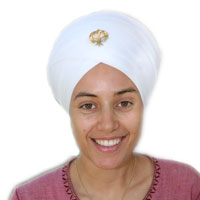

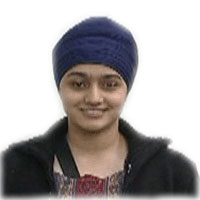
(Hope no one is offended on my commentaries on the few examples of different styles of pagh). The turban is our Guru's gift to us. It is how we crown ourselves as the Singhs and Kaurs who sit on the throne of commitment to our own higher consciousness. For men and women alike, this projective identity conveys royalty, grace, and uniqueness. It is a signal to others that we live in the image of Akal Purakh and are dedicated to serving all. The turban doesn't represent anything except complete commitment. When you choose to stand out by tying your turban, you stand fearlessly as one single person standing out from six billion people. It is a most outstanding act. The turban on a physical level protects our Kesh, covers our head (and dasam duaar, spiritual gate on top of head) and creates a physical reminder to oneself and the world of who's son and daughter you are and how you live an admirable and chardikala way of life.
It was good to see uncle jee's, aunty jee's and children all in a learning environment and having fun. Most children learnt the technique of tying a pagh. They were given a pagh to take home. Till next week they have time to mess around and play about with the Pagh and try to learn how to tie it. Coming back next week they get help and tips etc. Eventually there will be Dastaar (turban) tying contest on Vaisakhi with prizes. So the children are excited in tying a good looking pagh. The age of children was from 11 to 16. So basically secondary school age. The aunty jee's and uncle jee's invited for next week as well and also given me 10 minutes to give a talk about why we tie a Dastaar.
Afterwards I listened to Keertan and then met up with Bhenji Seleena Kaur. We were going to the radio and walking down the broadway and we came across a Gujrati Hindi-speaking elderly gentleman. In Hindi he called us over and asked for help. He looked a bit shaken up. He said that his wife has gone shopping to buy something (in particular). She was meant to buy it and come back, but she hasn't. He said its been half an hour and she hasn't arrived. I said that ladies do take time when browsing shops, and that he shouldn't worried. Sat Naam! Poor guy had tears in eyes and said, "my wife recently had a hear by-pass. We usually never leave each other and go to shops together. She doesn't have her mobile. I am worried for her health." Poor bloke was distraught but I didn't know what I could do other than do an Ardaas! So I told the man (in Hindi, well it was Panjabi with one or two Hindi words!) "Bhai Sahib have faith in Rab (God). God Willing, she is fine and just gone to browse other shops. 30 minutes is long. Please stand near the car so that if she comes back you don't miss her." He sounded relieved to talk to us and then we left him. We didn't help him really, but the man seemed a lot more calmer and relieved sharing his worry.
To be continued...

Comments